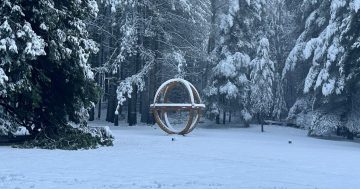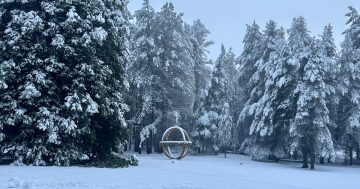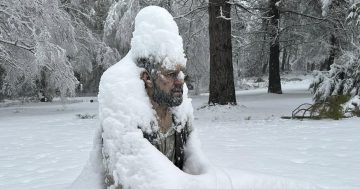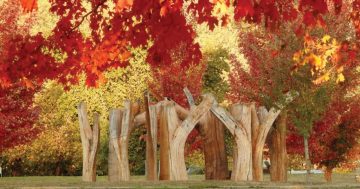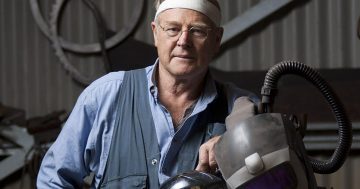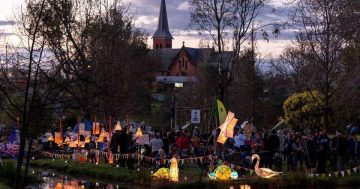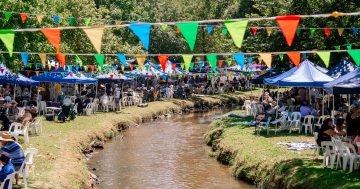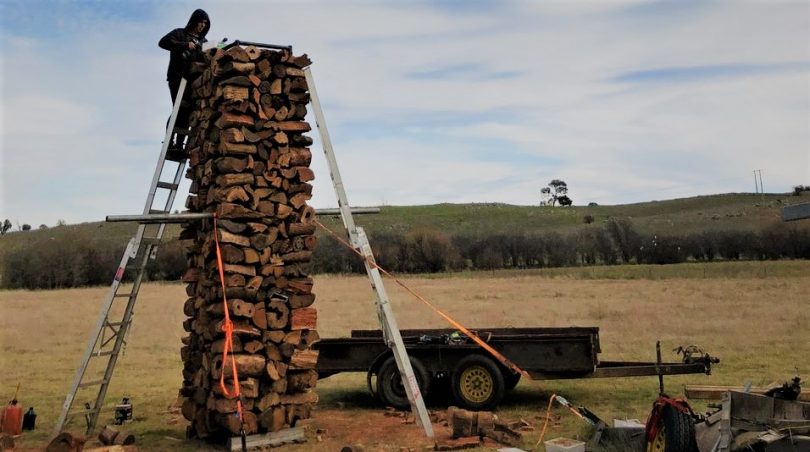
Australian sculptor Marcus Tatton spent the winter months near Yass working on “Habitat” which is the first in a series of sculptures bound for the Snowy Valleys. Photo: Supplied.
It wasn’t that long ago that one of Australia’s foremost sculptors was ladder deep in piles of wood near Yass, chipping away at an installation set to elevate the Snowy Valleys high country to dizzying heights of tourism.
So shrouded is this initiative even the Snowy Valleys Mayor James Hayes can’t talk about it, but he’s beyond euphoric at the news that the famed Sculpture by the Sea will now be linked to the Snowies.
Up to $4 million has been provided for this project that will see Sculpture by the Sea create a 100 kilometre Snowy Valleys Sculpture Trail.
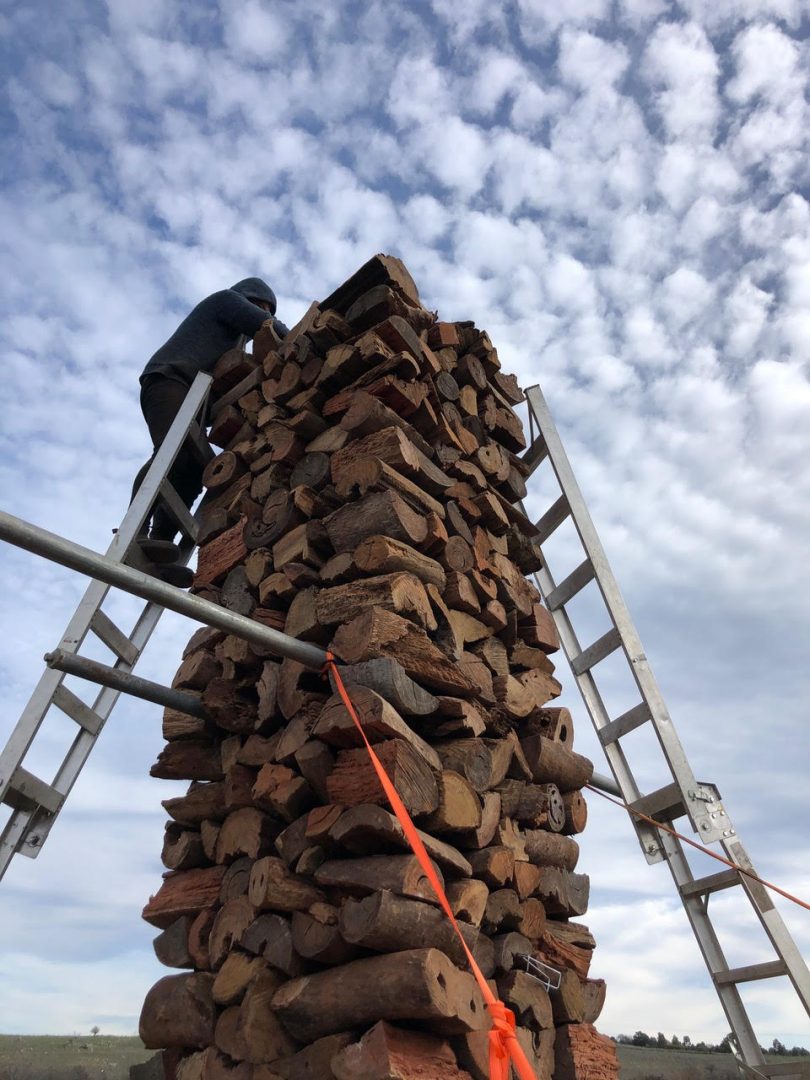
Stacks of firewood were used to form the chimney for “Habitat” which is the be housed on the Tumbarumba Creekscape with two other sculptures. Photo: Supplied.
The announcement came in June 2021 as Stage Two of the Bushfire Local Economic Recovery Fund were announced, with 195 projects across NSW sharing in $283 million designed to help communities recover from 2019/20’s Black Summer fires.
But the details of the range of sculptures which will snake through the historic towns of Adelong, Batlow, Tumbarumba and Tooma on the Snowy Valleys Way, culminating in construction of a world-class sculpture collection in Bago State Forest, are something of a mystery.
For Mayor Hayes, this collection on a major touring route between Sydney and Melbourne, leading into Kosciuszko National Park, is the perfect panacea for the beleaguered region.
“This is just about the best thing that could have happened to us,” he said.
“It really is big news for the region.”
Leading the way is Marcus Tatton – one of Australia’s best known public place sculptors who has been working on one installation set for permanent exhibition with two others in Tumbarumba’s very central Creekscape.
Far from his usual life among the wild, virgin woodscapes of Tasmania and due to COVID restrictions, Marcus found himself near Yass with chainsaw creating the work from fallen grey, yellow box and red river gum trees sourced from the Riverina.
“It’s what I do – I carve from those areas that have been logged, burnt and are being resown. I access the wood before it rots,” he said.
Usually in rugged, isolated circumstances, Marcus explores the relationship between the natural and man-made environments, how humans interact with nature and the effect they have on the landscape.
His impressive body of work – using natural and industrial waste material constructions, cast concrete and fabricated steel projects – has evolved over some 32 years, both nationally and internationally.
Canberrans will be familiar with his largest sculpture – a 42 metre corten steel ‘scraggle of old fence wire’ entitled ‘wide brown land’ – installed at the Canberra Arboretum in June 2010.
His association with Sculpture by the Sea has been strong – he’s shown at Cottesloe in Western Australia five times, Bondi about 17 times and in Aarhus, Denmark three times.
READ ALSO: Sculptural artists reach out to regional areas
The work for Tumbarumba – entitled “Habitat” – uses stacks of firewood to form a seven-metre high, 2.5-metre wide freestanding chimney, supported by a concrete footing and steel infrastructure.
“When you see a chimney in a paddock it is quite a ubiquitous form in the forests or landscapes which tells of past lives and endeavours,” he said.
“With this work you can actually walk into the hearth of the chimney and look right up through the chimney to the sky,” he said.
Being transported in two sections down the Hume Highway via truck will be a sight to behold, but as winter bows to spring up there, the unveiling of “Habitat” – at a date yet to be set – is lending an air of excitement to the community.
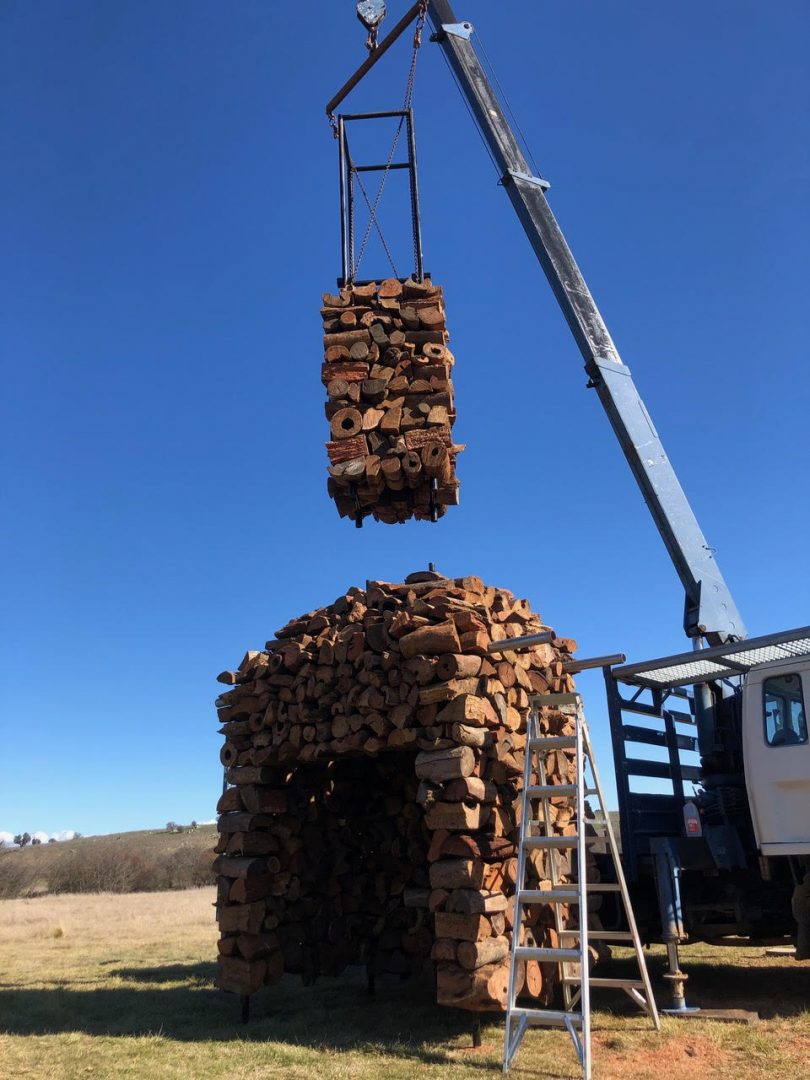
Created in two sections, “Habitat” will be transported by truck to Tumbarumba ahead of the official opening on a date to be confirmed. Photo: Supplied.
“We felt after the fires that creating sculpture would be a good way to invigorate the community, to bring people back into the area which was otherwise fraught with rebuilding and healing,” Marcus explained.
“To bring a woodstacked sculpture into this community too early – I had a feeling it would not be accepted at all – to create a ruin of a broken chimney – but since the fires the Tumbarumba community have rallied back and they thought this was a poignant statement – almost a memorial or monument to the fires,” he said.
Sculpture by the Sea is known to the area through recent school workshops and several community meetings, some of which Marcus attended, and so it has become the antidote to the embattled mountain people seeking a remedy for their post-bushfire and COVID-restricted lives, with positive results.
For Marcus it was the immediate sense of resilience of a community which had to keep restarting in uneasy times that seemed so remarkable. But this community had also lost one of their core historic attractions – the Sugar Pine Forest – which for years acted as the centrepiece for big local celebratory occasions but also acted as a conduit in attracting visitors to the area.
“It was truly remarkable to hear the community speak so movingly about the loss of their living grove of cathedral like trees,” Marcus said.
Hopes now lie in the Snowy Valleys Sculpture Trail and its capacity to provide present and future generations with a tangible monument to loss, new beginnings and that enduring indestructible spirit.
“I feel that we’re all in this together, the fires could engulf any one of our lives as we live amongst the trees in Australia. It is an honour to create a symbolic marker of the loss, the complete chaos that fires have wrought, and also of the regeneration and innate creative drive that sees us start from scratch, eking out our home in these harsh Australian landscape,” Marcus said.
The Habitat sculpture in Tumbarumba Park is one of three sculptures being gifted to Snowy Valleys by the Danish, Australian and New Zealand Friendship Association.
Original Article published by Edwina Mason on About Regional.












